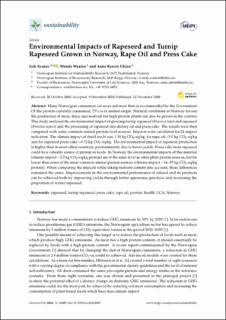| dc.contributor.author | Svanes, Erik | |
| dc.contributor.author | Waalen, Wendy | |
| dc.contributor.author | Uhlen, Anne Kjersti | |
| dc.date.accessioned | 2021-02-10T15:12:03Z | |
| dc.date.available | 2021-02-10T15:12:03Z | |
| dc.date.created | 2021-01-04T11:45:42Z | |
| dc.date.issued | 2020-12-12 | |
| dc.identifier.citation | Sustainability. 2020, 12:10407 (24), 1-22. | en_US |
| dc.identifier.issn | 2071-1050 | |
| dc.identifier.uri | https://hdl.handle.net/11250/2727269 | |
| dc.description.abstract | Many Norwegian consumers eat more red meat than is recommended by the Government. Of the protein currently consumed, 75% is of animal origin. Natural conditions in Norway favour the production of meat, dairy and seafood but high-protein plants can also be grown in the country. This study analysed the environmental impact of growing turnip rapeseed (Brassica rapa) and rapeseed (Brassica napus) and the processing of rapeseed into dietary oil and press cake. The results were then compared with some common animal protein food sources. Impacts were calculated for 24 impact indicators. The climate impact of dried seeds was 1.19 kg CO2-eq/kg, for rape oil—3.0 kg CO2-eq/kg and for rapeseed press cake—0.72 kg CO2-eq/kg. The environmental impact of rapeseed production is higher than in most other countries, predominantly due to lower yields. Press cake from rapeseed could be a valuable source of protein in foods. In Norway, the environmental impacts of this material (climate impact—2.5 kg CO2-eq/kg protein) are at the same level as other plant protein sources, but far lower than some of the most common animal protein sources (climate impact—16–35 kg CO2-eq/kg protein). When comparing the impacts while taking nutrient content into account, these differences remained the same. Improvements in the environmental performance of oilseed and its products can be achieved both by improving yields through better agronomic practices and increasing the proportion of winter rapeseed. | en_US |
| dc.language.iso | eng | en_US |
| dc.publisher | MDPI, Basel, Switzerland | en_US |
| dc.rights | Navngivelse 4.0 Internasjonal | * |
| dc.rights.uri | http://creativecommons.org/licenses/by/4.0/deed.no | * |
| dc.title | Environmental impacts of rapeseed and turnip rapeseed grown in Norway, rape oil and press cake | en_US |
| dc.type | Peer reviewed | en_US |
| dc.type | Journal article | en_US |
| dc.description.version | publishedVersion | en_US |
| dc.rights.holder | © 2020 by the authors | en_US |
| dc.source.pagenumber | 1-22 | en_US |
| dc.source.volume | 12:10407 | en_US |
| dc.source.journal | Sustainability | en_US |
| dc.source.issue | 24 | en_US |
| dc.identifier.doi | 10.3390/su122410407 | |
| dc.identifier.cristin | 1864698 | |
| dc.relation.project | Norges forskningsråd: 267858 | en_US |
| dc.source.articlenumber | 10407 | en_US |
| cristin.ispublished | true | |
| cristin.fulltext | original | |
| cristin.qualitycode | 1 | |

